 Ceram, Moluccas, Netherlands East Indies'
Ceram, Moluccas, Netherlands East Indies'
Oil Field
Under Imperial Japanese Navy Control
By Bob Hackett
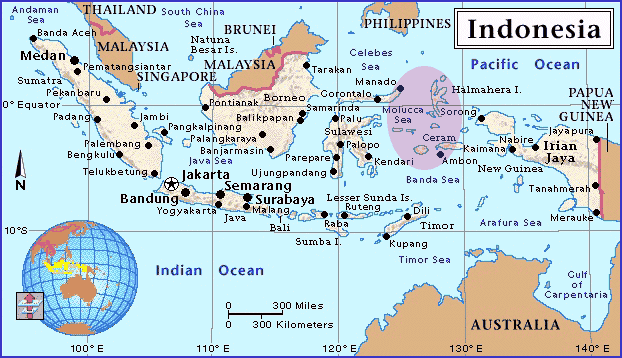 Ceram's Location in relation to the Philippines,
Singapore, Sumatra, Celebes (Sulawesi), Papua New Guinea and
Austalia
© Bob Hackett February 2014
Ceram's Location in relation to the Philippines,
Singapore, Sumatra, Celebes (Sulawesi), Papua New Guinea and
Austalia
© Bob Hackett February 2014
Ceram (now Seram) Island is the largest island of the Maluku province of
Indonesia. It is located just north of Ambon Island. The Boela (Bula) field, on
the northeastern tip of Ceram was discovered in 1897. In 1913, the field was
developed by two Royal Dutch-Shell subsidiaries. Its pre-war output from about
500 wells had a rated potential production of 650,000 barrels a year, or 1,800
barrels a day. In 1939, the field reached a peak production of 750,000 barrels.
There was no refinery at Boela and the crude was shipped to Balikpapan, Borneo
for refining.
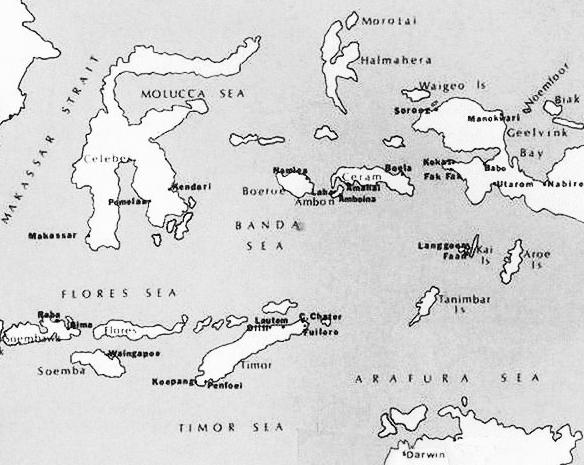 Map showing location of Boela on Ceram Island
In January 1942, Boela, one of the oldest oil fields in the Netherlands
East Indies, was destroyed by the Dutch before they withdrew.
On 27 March 1942, the Japanese "N" Expeditionary Force under Rear Admiral
(later Vice-Admiral) Fujita Ruitaro’s (38) command, assembled at Ambon Island
and included a Transport Force consisting of the auxiliary transport HOKUROKU
MARU, 2nd Gunboat Division with auxiliary gunboats MANYO, TAIKO and OKUYO MARUs,
and auxiliary netlayer SEIAN MARU acting as supply ship. The Transport Force
carried the 4th Guard Unit (elements of Sasebo Combined Naval Special Landing
Force (SNLF) and the 24th Special Base Unit (about 500 men). Escort was provided
by CarDiv 11’s seaplane carrier CHITOSE, CruDiv 16/3’s KINU, DesDiv 16/1's
YUKIKAZE and TOKITSUKAZE, torpedo boats TOMOZURU, HATSUKARI, patrol boats Nos.
1, 2, 38 and No. 39, SubChasDiv 54's SHONAN MARU Nos. 5 and 17 and FUKUEI MARU
No. 15 and other smaller craft.
On 29 March 1942, the "N" Expeditionary Force departed Ambon for Ceram
Island arriving at Boela on 31 March 1942. The town is found deserted. During
1942, the Japanese re-built tanks and drilling rigs and brought the Boela field
into production once more. On 7 October 1942, Royal Australian Air Force (RAAF)
Lockheed "Hudson" light bombers attacked the new oil facilities at Boela.
From 17, June 1943 through 25 October 1944, LtGen (later General) George
C. Kenney’s Allied Air Forces in the Southwest Pacific Area (SWPA), consisting
of both USAAF) and Royal Australian Air Force (RAAF) units, bombed the Boela oil
fields and oil storage tanks on Ceram. During this period, Kenney employed the V
Bomber Command’s 43rd Bombardment Group’s (H) Consolidated “Liberator” heavy
B-24 heavy bombers based at Townsville on the NE coast of Queensland, Australia
and the 90th Bombardment Group’s (H) and 380th Bombardment Group’s (H) B-24s
based at Fenton airfield 80 miles inland from Darwin, Northern Territory,
Australia.
Map showing location of Boela on Ceram Island
In January 1942, Boela, one of the oldest oil fields in the Netherlands
East Indies, was destroyed by the Dutch before they withdrew.
On 27 March 1942, the Japanese "N" Expeditionary Force under Rear Admiral
(later Vice-Admiral) Fujita Ruitaro’s (38) command, assembled at Ambon Island
and included a Transport Force consisting of the auxiliary transport HOKUROKU
MARU, 2nd Gunboat Division with auxiliary gunboats MANYO, TAIKO and OKUYO MARUs,
and auxiliary netlayer SEIAN MARU acting as supply ship. The Transport Force
carried the 4th Guard Unit (elements of Sasebo Combined Naval Special Landing
Force (SNLF) and the 24th Special Base Unit (about 500 men). Escort was provided
by CarDiv 11’s seaplane carrier CHITOSE, CruDiv 16/3’s KINU, DesDiv 16/1's
YUKIKAZE and TOKITSUKAZE, torpedo boats TOMOZURU, HATSUKARI, patrol boats Nos.
1, 2, 38 and No. 39, SubChasDiv 54's SHONAN MARU Nos. 5 and 17 and FUKUEI MARU
No. 15 and other smaller craft.
On 29 March 1942, the "N" Expeditionary Force departed Ambon for Ceram
Island arriving at Boela on 31 March 1942. The town is found deserted. During
1942, the Japanese re-built tanks and drilling rigs and brought the Boela field
into production once more. On 7 October 1942, Royal Australian Air Force (RAAF)
Lockheed "Hudson" light bombers attacked the new oil facilities at Boela.
From 17, June 1943 through 25 October 1944, LtGen (later General) George
C. Kenney’s Allied Air Forces in the Southwest Pacific Area (SWPA), consisting
of both USAAF) and Royal Australian Air Force (RAAF) units, bombed the Boela oil
fields and oil storage tanks on Ceram. During this period, Kenney employed the V
Bomber Command’s 43rd Bombardment Group’s (H) Consolidated “Liberator” heavy
B-24 heavy bombers based at Townsville on the NE coast of Queensland, Australia
and the 90th Bombardment Group’s (H) and 380th Bombardment Group’s (H) B-24s
based at Fenton airfield 80 miles inland from Darwin, Northern Territory,
Australia.
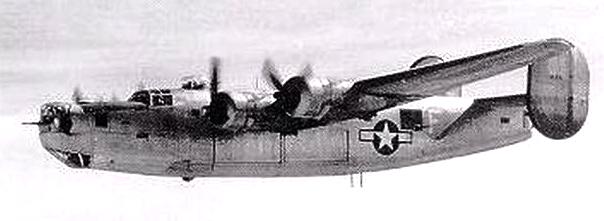 Consolidated B-24 “Liberator”
On 17 July 1944, Douglas A-20 “Havoc” light bombers of the Fifth Air
Force’s 3rd Bombardment Group based at Hollandia, New Guinea conducted one its
longest raids when it struck the Boela oil fields. In September 1944, RAAF 22
Squadrons' Douglas A-20 “Bostons” and RAAF 30 Squadrons' Bristol “Beaufighters”
from Noemfoor, Papua New Guinea attacked Boela's airstrips. That same month,
USAAF A-20s, B-24s, North American B-25 "Mitchell" medium bombers, Lockeed P-38
"Lightning" fighter-bombers and Republic P-47 "Thunderbolt" f igher-bombers
bombed and strafed airstrips, oil tanks, derricks, ammunition dumps and a radio
station on Boela.
Consolidated B-24 “Liberator”
On 17 July 1944, Douglas A-20 “Havoc” light bombers of the Fifth Air
Force’s 3rd Bombardment Group based at Hollandia, New Guinea conducted one its
longest raids when it struck the Boela oil fields. In September 1944, RAAF 22
Squadrons' Douglas A-20 “Bostons” and RAAF 30 Squadrons' Bristol “Beaufighters”
from Noemfoor, Papua New Guinea attacked Boela's airstrips. That same month,
USAAF A-20s, B-24s, North American B-25 "Mitchell" medium bombers, Lockeed P-38
"Lightning" fighter-bombers and Republic P-47 "Thunderbolt" f igher-bombers
bombed and strafed airstrips, oil tanks, derricks, ammunition dumps and a radio
station on Boela.

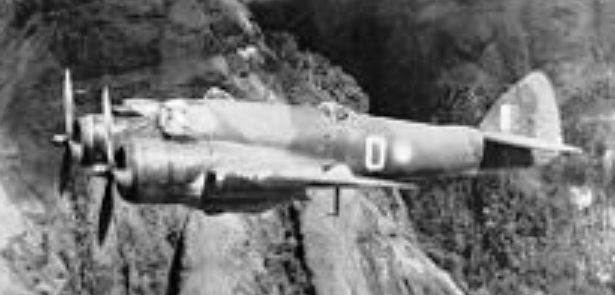 (RAAF 22 Squadron Boston and RAAF 30 Squadron
Beaufighter)
On 22 October 1944, P-38s of the 12th Fighter Squadron flew the first
tactical napalm mission in the Southwest Pacific Area, dropping 75-gallon belly
tanks of napalm on oil storage tanks at Boela. The squadron, assigned to the
18th Fighter Group, XIII Fighter Command, was operating from Sansapor, New
Guinea.
(RAAF 22 Squadron Boston and RAAF 30 Squadron
Beaufighter)
On 22 October 1944, P-38s of the 12th Fighter Squadron flew the first
tactical napalm mission in the Southwest Pacific Area, dropping 75-gallon belly
tanks of napalm on oil storage tanks at Boela. The squadron, assigned to the
18th Fighter Group, XIII Fighter Command, was operating from Sansapor, New
Guinea.
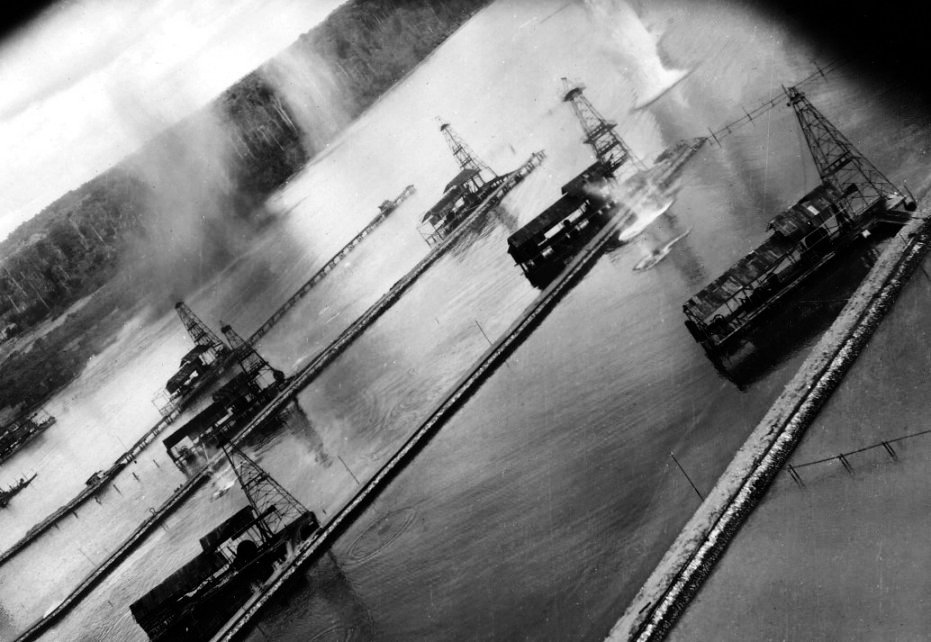 Boela Oil Field Under Atack
(USAAF 3rd Bomb Group photo by Jack Heyn)
In addition to ground AA, Japanese opposition was generally light
consisting mainly of Ambon’s IJN 202nd Kokutai’s A6M “Zeke” fighters, 934th
Kokutai’s Nakajima A6M2-N “Rufe” float
fighters and the IJAAF 5th Sentai's Kawanishi Ki-45 “Nick” twin-engine fighters.
Boela Oil Field Under Atack
(USAAF 3rd Bomb Group photo by Jack Heyn)
In addition to ground AA, Japanese opposition was generally light
consisting mainly of Ambon’s IJN 202nd Kokutai’s A6M “Zeke” fighters, 934th
Kokutai’s Nakajima A6M2-N “Rufe” float
fighters and the IJAAF 5th Sentai's Kawanishi Ki-45 “Nick” twin-engine fighters.
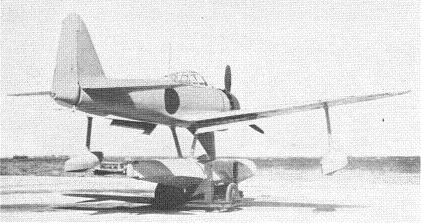
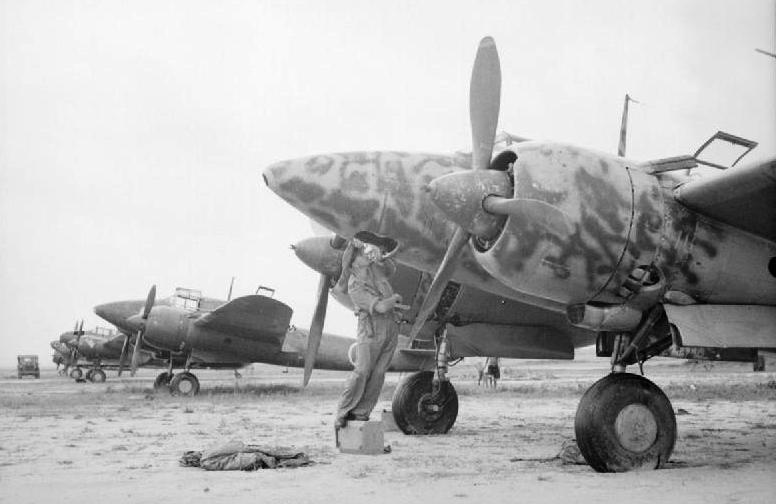 A6M2-N “Rufe” float
fighters and Ki-45 “Nick” night fighters
The Boela Oil Field remained under Japanese control until the end of the
war.
A6M2-N “Rufe” float
fighters and Ki-45 “Nick” night fighters
The Boela Oil Field remained under Japanese control until the end of the
war.













